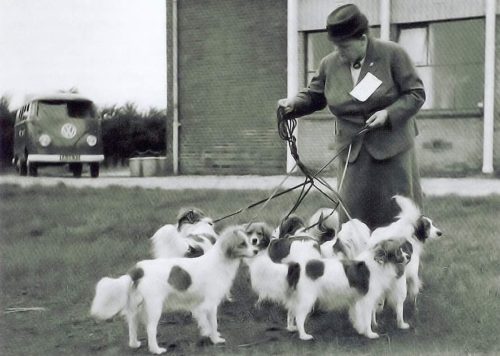
In the photograph is the Baroness von Hardenbroeck von Ammerstol and her pack of Kooikerhondjen at the first evaluation day in 1961. But we get ahead of ourselves.
The history of the Kooikerhondje goes back at least as far as the 17th century as evidenced by its appearance in paintings by Rembrandt, Jan Steen, J.A. Kruseman, and other Dutch masters. Before that, some cynologists believe that it was the Spaniards who brought the dogs to the Netherlands during Spanish leadership in the 15th century.
Kooikers were originally developed and used by Dutch hunters to lure ducks into traps called eendenkoois that were built on wetlands and along canals in the Netherlands. The dog, which takes its name from the hunter and traps, worked with the duck hunter, or kooiker, by responding to hand signals to lure the ducks down a net-covered canal and into the trap. Kooiers “tolled,” caught the duck’s attention, by weaving through blinds, their white tipped tail drawing the curiosity of the ducks which would follow along and be trapped. After duck hunting season, Kooikerhondjes served as vermin control by dispatching weasels, rats, moles and mice found in crops, storage areas, and and fields. It was a family companion, and certainly in the case of Prince William II of Orange, a protector: A Kooikerhondje is credited with saving his life in an assassination attempt by alerting him in the night.
Sadly, WWII was devastating to the breed, and diminishing numbers of wild duck stock only aggravated the situation. By 1939, only about 25 Kooikers were believed to be left in existence.
It was the Baroness Van Hardenbroek van Ammerstol who took an interest in the breed and began to rebuild it. As the story goes, she gave a picture of the dog she was looking for to a pedlar and asked him to keep his eyes open. The pedlar indeed did! He found a bitch at a farm in the province of Friesland, a dog that could be known as “Tommie.” She was bred to “Bobbie,” and together they produced the first litter in 1942. Sadly, the only surviving pup was named “Bernard van Walhalla.” Tommie was mated with another dog, and in 1943, she whelped four bitches that were named after the princesses of Netherland. Thus, breed number steadily increased. Today, Tommie is regarded as the foundation bitch of the reconstituted Kooikerhondje. In 1971, the Dutch Kennel Club, or Raad van Beheer, officially recognized the breed, and while it’s still rare in North America, awareness (and breed numbers) are growing as people discover this marvelous breed.
